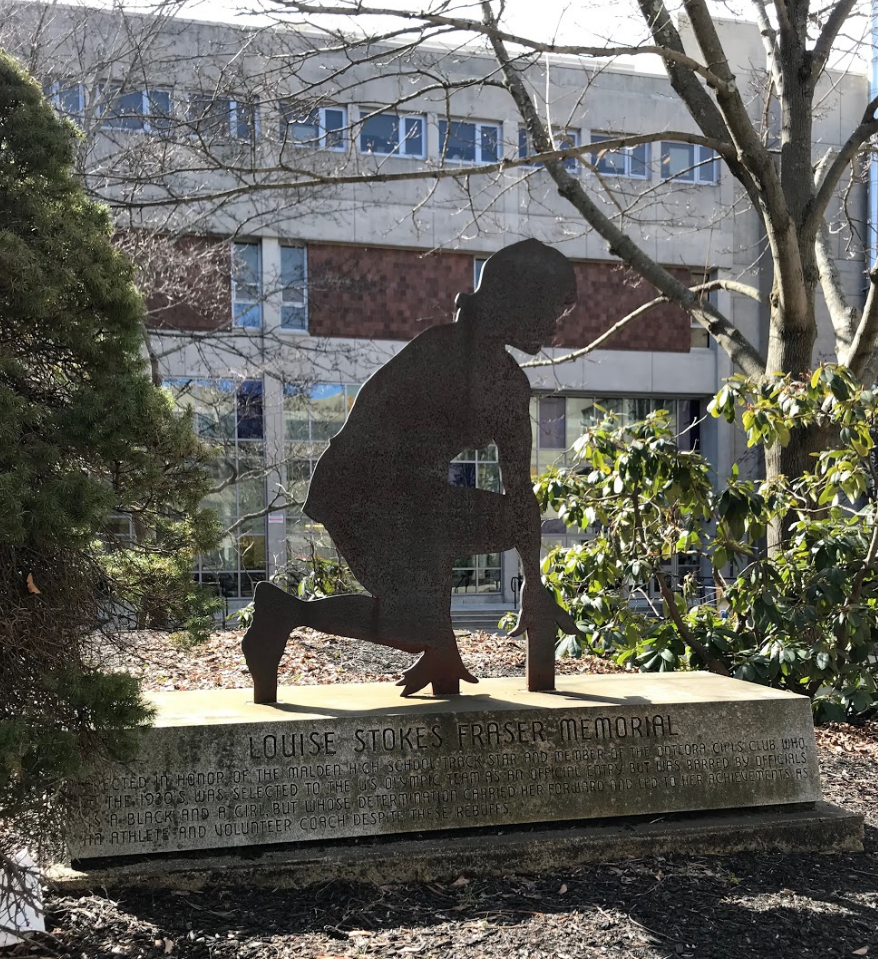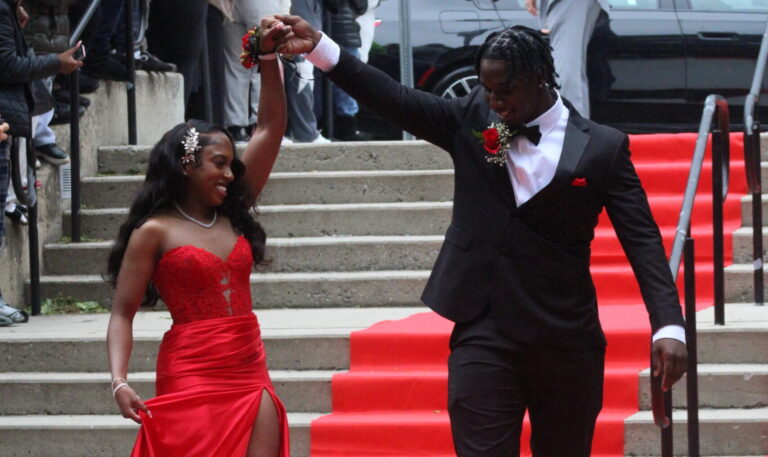
A statue of Louise Stokes Fraser highlighted in the Malden High School courtyard. Photo taken by Jesaias Benitez.
WHY I CHOSE TO WRITE ABOUT LOUISE STOKES FRASER:
Fraser’s inspirational story should be told throughout Malden.
I was introduced to Louise Stokes Fraser by my American Law teacher, Mark Capansky, who showed us a google slide about a woman who faced great odds to pursue her passion as a runner. Then, he told my class that we have to go to the courtyard. At first, we complained about the coldness. Many of us stood in front of the statue questioning why he would bring us outside to see a statue that we have seen plenty of times before. However, he told us to read the engraving. As a class, we were in shock that someone with such an inspirational story went to our high school and that we did not know her.
So, I decided to learn more about Louise Stokes Fraser. I found the documentary Olympic Pride, and American Prejudice. I read countless articles to find out more information about her life and track records at Malden High School. My newspaper advisor, Ryan Gallagher, and I looked at archives from the late 1920’s to the early 1930’s to see if she was featured in any articles from The Blue and Gold newspaper back then.
I’ve lived in Malden all 18 years of my life, and had older siblings that went to Malden High School, and I never knew until now the story of Louise Stokes Fraser. Her persistence and stride throughout her years as a runner during a time period that was deemed an obstacle within itself is truly remarkable.
When I first came to Malden High School in the fall of 2014, I attended my first play in the Jenkins auditorium. I was with my mother when I noticed one of the display cases outside the auditorium. There were old yearbooks of the play production shows from decades ago. There were pictures of people getting ready for shows, in particular, minstrel shows. I felt embarrassed. I did not want my mom to see the past realities of my high school that I had so much pride in.
It was not until my junior year, when I expressed this story to my English teacher, Margaret Giberson, that I understood how it impacted me. She is someone who has always displayed extraordinary care for her students and their well being inside and outside of the school. I trusted her to tell her how I felt. As soon as I talked to her about it, she immediately made sure it came down and thanked me for making her aware.
I have realized my passion for learning more about black history. We should realize the importance of celebrating Black History in Malden but also acknowledge our problematic past. I think, as a community, we do a disservice to the younger generations growing up in Malden when past and current issues are not addressed. If the sole focus of the high school is only celebrating our diversity, then we will fail to fix other some important issues in equality and fairness.
LOUISE STOKES FRASER’S STORY:
After the abolishment of slavery, America failed to find ways to integrate a population of people who weren’t given the basic acknowledgement of being humans. The neglect continued even more throughout the 1930’s in the midst of The Great Depression.
During this time, in a city about six miles out of Boston, a runner by the name of Louise Stokes attended Malden High School. Of course, because of her circumstances, being a person of color, a female, and dealing with the racial tribulation of being a black person in America, Fraser faced many obstacles as a runner.
Stokes’ agility was undeniably good. While attending the Beebe Junior High School, Fraser played basketball. While on the basketball team, people around her suggested that she should try running for the track and field team.
Once Stokes attended Malden High School, she was heavily involved in basketball and track and field. She graduated in the Class of 1931.
When I was researching this for my article, I searched through the Malden High yearbooks. I learned that there were two separate yearbooks for this graduating class. Louise Stokes was not in the yearbook that is in the archives, and I could not locate the other yearbook.
In the documentary Olympic Pride, and American Prejudice, Fraser’s son, Wilfred Fraser Jr., reminisced about old stories that he was told as a child, about his mother competing with boys her age in races on the old train tracks. Fraser’s competitiveness pushed her to practice at the railroad tracks every morning. Soon, Fraser Jr. explained, “she became quite good at it, and after a while she started beating the boys”.
Louise Stokes is honored at Bridgewater State, and the following is on their website:
“In September 1931, while a junior at Malden High School, she was awarded the James Michael Curley Cup for outstanding women’s track performance of the year. At the Mayor’s Day Races, Louise set a New England record of 12.6 in the 100-meter race, second place in the 50-yard dash, and third in the broad jump. Four months later, in December, at a YMCA meet held in Roxbury, MA, she tied the world record for women in the standing broad jump at 8′ 5 3/4″. Louise won the National Junior 40-yard dash championship and defended her broad jump record in Princeton, New Jersey in early 1932, and went on to win the New England Championship in the high jump and finish second in the 100-yard dash in June at a Boston Parks Department meet.”
In 1932, the Olympic trials were held at Northeastern University for the upcoming Olympics in Los Angeles. Being one of the only two African American females to place a spot on the American team, Stokes placed third in the 100 meter trials. She was ready to be on the 400 meter Olympic team. However, before the Olympics, she was replaced by a white runner. The only other African American female runner, Tidye Pickett, was replaced as well, by a white women.
Stil, Stokes tried out for the upcoming Olympics in Berlin in 1936. At the Olympic trials in Brown University she managed to place 5th, which landed her a spot on the 400 meter relay team. Sadly, much like 1932 Olympics, Louise Stokes Fraser was replaced again. During this time, back in the United States, blacks were still segregated from whites. Also, in Berlin, Germany, Adolf Hitler was still in regime. Hitler used the Olympics to display his German team so the rest of the world could see their athleticism. Hitler was not prepared for African American, non blonde-haired, blue eyed, Jesse Owens to win multiple gold medals.
As for Stokes, her tribulations did not prevent her from being heavily involved in sports. Later, Stokes became a professional bowler, even starting her own Colored Women’s Bowling league. During this time, in 1944, she married Wilfred Fraser, who was also an athlete. Wilfred Fraser played cricket. Together, they had a son, Wilfred Jr. Fraser. Sadly, on March 25, 1978 Louise Stokes Fraser died.




Hello, Sidney, Thank you for your great research into Louise Stokes Fraser! I just wanted you to know i made a findagrave memorial for Louise. It has lots of photos and info. Did you ever find that other Malden HS yearbook with her photo in it? I looked on yearbooks.com and couldn’t find a photo of her in any of the Malden the yearbooks either. I would like to find a photo of her when she was a bowling professional and started the “Colored Women’s Bowling League”. Have you ever seen one? So far, i’ve not located one, but if i do, i will put it on her findagrave.
Ciao! ~ Linda
PS: forgot to leave you the link to her findagrave memorial i made:
https://www.findagrave.com/memorial/216266511/louise-mae-fraser